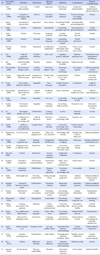Abstract
Methods
Cultural nursing competence was analyzed using Rodgers' evolutionary concept development method. A literature search using the keywords "cultural nursing competence", "intercultural nursing competence", "cultural nursing", "cultural health nursing", and "cultural competence" was conducted in PubMed, CINAHL, ERIC, and RISS on material published before 2015. Database and bibliographic searches yielded 35 records.
Results
Cultural nursing competence comprised cognitive, affective, and behavioral domains. The critical attributes of the concept were sensitivity, equality, and activity. The analysis identified the following dimensions: awareness, openness, and coherence. The consequences of cultural nursing competence were personal satisfaction and social justice. The definition contained competence on both an individual and social level.
Conclusion
Cultural competency enhances quality of care by narrowing health disparities and increasing client satisfaction. The concept analysis of cultural nursing competence may offer an acceptable framework which can be used to develop psychometric tools of this concept and provide guidelines in nursing practice.
Figures and Tables
Table 1
Concept Analysis of the Reviewed Research Papers (N=35)

Table 2
Attributes of Cultural Nursing Competency

Summary Statement
▪ What is already known about this topic?
While several studies have applied cultural competence into nursing, there was lack of studies analyzing a concept of cultural nursing competence.
▪ What this paper adds?
The attributes of cultural nursing competence are sensitivity, equality, and activity. The cultural nursing competency is defined as understanding and respecting client's culture and providing care to be congruent with their culture. Cultural nursing competence bring about increasing client's satisfaction and improving care quality.
▪ Implications for practice, education and/or policy
The concept analysis of cultural nursing competence may offer an acceptable framework which can be used to develop psychometric tools of this concept and provide guidelines in nursing practice.
References
1. Jeong GH, Nam KA, Kim YS, Park HS, Kim SK. Transcultural nursing. Chuncheon: Xmlarchive;2012.
2. Humes KR, Jones NA, Ramirez RR. Overview of race and Hispanic origin: 2010 Census Briefs. U. S. Department of Commerce Economics and Statistics Administration U. S. Census Bureau;2010. March. p. 1–23.
3. Clark L, Zuk J, Baramee J. A literary approach to teaching cultural competence. J Transcult Nurs. 2000; 11(3):199–203.

4. Han SY, Cho Chung HI. Development of a cultural competence scale for nursing students. J Korean Acad Nurs. 2015; 45(5):684–693.

5. Gebru K, William A. Education to promote culturally competent nursing care-a content analysis of student responses. Nurse Educ Today. 2010; 30(1):54–60.
6. Zander PK. Cultural competence: Analyzing the construct. J Theory Constr Test. 2007; 11(2):50–54.
7. Aponte J. Addressing cultural heterogeneity among hispanic subgroups by using Campinha-Bacote's model of cultural competency. Holistic Nursing Practice;2009. January. p. 3–12.
8. Evans E. An elective course in cultural competence for health care professionals. Am J Pharm Educ. 2006; 70(3):55.
9. Engebretson J, Mahoney J, Carlson ED. Cultural competence in the era of evidence-based practice. J Prof Nurs. 2008; 24(3):172–178.

10. Dudas KI. Cultural competence: An evolutionary concept analysis. Nurs Educ Perspect. 2012; 33(5):317–321.
11. Isaacson M. Clarifying concepts: Cultural humility or competency. J Prof Nurs. 2014; 30(3):251–258.

12. Suh EE. The model of cultural competence through an evolutionary concept analysis. J Transcult Nurs. 2004; 15(2):93–102.

13. Rodgers BL, Knafl KA. Concept development in nursing: Foundations, techniques, and application. 2nd ed. Philadelphia, PA: Saunders;2000.
14. STROBE Statement-Items to be included when reporting observational studies [Internet]. Bern, Switzerland: University of Bern;2009. Cited 2013 August 12. Available from: http://www.strobe-statement.org/index.php?id=available-checklists.
15. Chenowethm L, Jeon YH, Goff M, Burke C. Cultural competency and nursing care: An Australian perspective. Int Nurs Rev. 2006; 53(1):34–40.

16. Koprucu S. Raising global citizens: Focus on cultural competency. School Business Affairs;2009. April. p. 30–32.
17. Flowers DH. Culturally competent nursing care: A challenge for the 21st century. Cult Divers. 2004; 24(4):48–52.
18. Epner DE, Baile WF. Patient-centered care: The key to cultural competence. Ann Oncol. 2012; 23:Suppl 3. 33–42.

19. Mohammadi N, Evans D, Jones T. Muslims in Australian hospitals: The clash of cultures. Int J Nurs Pract. 2007; 13(5):310–315.

20. Capell J, Dean E, Veenstra G. The relationship between cultural competence and ethnocentrism of healthcare professionals. J Transcult Nurs. 2008; 19(2):121–125.
21. Perng SJ, Watson R. Construct validation of the nurse cultural competence scale: A hierarchy of abilities. J Clin Nurs. 2012; 21(11-12):1678–1684.

22. Gunaratnam Y. Intercultural palliative care: Do we need cultural competence? Int J Palliat Nurs. 2007; 13(10):470–477.

23. Wilson DW. Culturally competent psychiatric nursing care. J Psychiatr Ment Health Nurs. 2010; 17(8):715–724.

25. Schumacher G. Culture care meanings, beliefs, and practices in rural dominican republic. J Transcult Nurs. 2010; 21(2):93–103.

26. Onorat MG, Bednarz F. Learning to become an intercultural practitioner: The case of lifelong learning intensive programme interdisciplinary course of intercultural competences. US-China Educ Rev. 2010; 7(6):54–62.
27. Feser L, Bon Bernard C. Enhancing cultural competence in palliative care: Perspective of an elderly chinese community in Calgary. J Palliat Care. 2003; 19(2):133–139.

28. Pergert P, AilingerEkblad S, Enskär K, Björk O. Bridging obstacles to transcultural caring relationships-Tools discovered through interviews with staff in pediatric oncology care. Eur J Oncol Nurs. 2008; 12(1):35–43.

29. Tofthagen R, Fagerstrøm LM. Rodgers' evolutionary concept analysis-a valid method for developing knowledge in nursing science. Scand J Caring Sci. 2010; 24:21–31.




 PDF
PDF ePub
ePub Citation
Citation Print
Print




 XML Download
XML Download